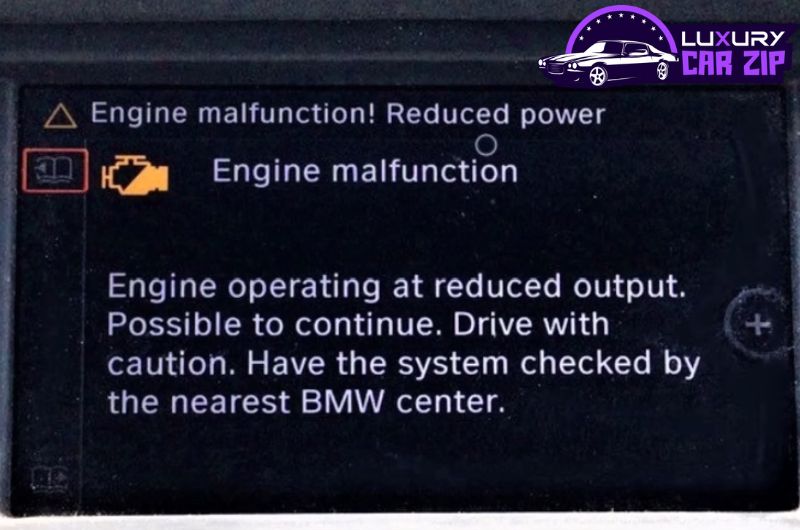What Causes BMW Engine Malfunction! Reduced Power?
The BMW brand has been in the car manufacturing game for a long time. They’ve introduced unique features to their clients. The Engine Malfunction Reduced Power is one of them. Now, it’s ok to wonder why BMW’s engine malfunction reduced power pops up on display?
Problematic Valvetronic, defective Vanos, loose oxygen wirings, damaged ignition coils, expired batteries, and loose turbo solenoids are responsible for the appearance of this message. Sometimes, defective HPFP and timing chains accelerate the issue even more.
Fixing most of the causes helps to solve this notification. However, it’s tough to fix them yourself. Installing a new turbo and repairing the timing chain is pretty expensive. So don’t try to DIY it if you are a fresh driver.

Contents
- 1 What Does BMW Engine Malfunction Reduced Power Mean?
- 2 Why BMW Engine Malfunction Reduced Power Showing?
- 3 Frequently Asked Questions (FAQs)
- 3.1 Is it safe to drive with the Engine Malfunction Reduced Power message?
- 3.2 What does ‘drive moderately’ mean for BMW?
- 3.3 Should I be worried if my BMW’s check engine light is ON?
- 3.4 Does the Malfunction Engine Reduced Power mean a low fuel-to-air ratio?
- 3.5 Does the Malfunction Engine Reduced Power notification hamper my BMW’s performance?
- 4 Bottom Line
What Does BMW Engine Malfunction Reduced Power Mean?
Your BMW isn’t performing at its peak if you notice the Engine Malfunction Reduced Power message on the screen. The vehicle signals when a system fails, or the engine isn’t functioning correctly. Consequently, you’ll fail to speed up your BMW.
This feature works like a fail-safe to protect the engine from further problems. It also pops up when the engine fails miserably. The messages’ summary may change depending on your BMW model.
They convey the same message: “full engine power is no longer available.” But you should avoid driving when you notice this message. Otherwise, you might face some unwanted incidents.
Why BMW Engine Malfunction Reduced Power Showing?
The message appears on your BMW for several reasons. Some problems are responsible for the appearance of this notification. This message is pretty terrible news for the vehicle and the owner.
Usually, fixing the problems above solves the engine malfunction message issue. So, you must focus on these problems and confirm them before you try to fix them.
Mechanics will scan the fault codes to find a solution. First, however, check out some quick fixes to solve this message-related issue faster.
Here are some of the issues causing this message and solutions in the latter part.
1: Defective Valvetronic
This sensitive yet durable engine part replaced the throttle plate regulating the intake. But a defective Valvetronic affects the throttle response and reduces engine power.
Finally, the electric motor and the eccentric shaft sensor also fail to increase the chances of the ‘Engine Malfunction Reduced Power’ message.
Valvetronic Fixing
You can reset the Valvetronic to its default state following this method.
- Step 01: Join the Valvetronic motor’s 2-pin plug.
- Step 02: Now, go to position 2 and change its position.
- Step 03: Press the accelerator pedal ten times, maintaining a 15 second interval.
The Valvetronic motor’s sound will confirm the rest.
Read Also>>Why Is BMW Catalytic Converter Not Ready? [With Solutions]
Read Also>>4 BMW X5 Hybrid Charging Options That You Should Know
2: Damaged Vanos
Oil slurry around the Vanos solenoid and inside damages this sensitive engine part badly. This will most likely happen if you irregularly change your BMW engine oil.
A damaged Vanos is also responsible for this notification. It increases the engine noise while starting a cold engine. You’ll see the 2A82 or 2A87 on your BMW display if it’s a Vanos-related issue.
Vanos Replacement
It would help if you verified the Vanos type before you fixed it. Generally, setting the Vanos actuator solves the single Vanos issue.
Replacing or cleaning the dual-type Vanos’s solenoid improves the dual-type Vanos. But it would help if you took your BMW to the mechanic to fix a faulty dual-type Vanos with Valvetronic.
3: Faulty Oxygen Sensor
Excess fuel consumption is responsible for a defective oxygen sensor. In addition, faulty wirings and connections worsen the matter further.
Since it directly affects the engine performance, the ‘Engine Malfunction Reduced Power’ notification comes directly on the vehicle’s dashboard. In addition, codes like 2C9C, P0171, or P0174 indicate this issue.
Fixing Oxygen Sensor Connections
If the oxygen sensors are at fault for sending the engine malfunction message, try to tighten the loosened wirings. Most of the time, fixing the connections resolves the oxygen sensor issue.
Read Also>>6 Possible Reasons & Fix for BMW Charging Malfunction
Read Also>>Which BMW X5 Years To Avoid & Why? Problems Explained
4: Ignition Coils Failure
Ignition coil failure is another reason behind this message. The engine shakes while starting due to a misfire. The shaking increases significantly if you try to increase the speed.
Defective ignition coils damage the catalytic converter. Consequently, a yellow light will confirm this message. If you still doubt this issue, code P0300 and P0306 DTC codes will ensure this.
Installing New Ignition Coils
Take your BMW to a repair shop to install new ignition coils. Before replacing the ignition coils, consider the repairing option.
The average cost of replacing the ignition coils is around $130 to $200. The mechanic will charge you between $60 to $75, whereas the parts cost around $70 to $125. The replacement cost increases with taxes and other charges.
5: Misplaced Timing Chain
Manufacturers claim timing chains have a lifelong warranty. The tensioners fail with time, illuminating the check engine light. The engine clatters if the teeth get misplaced.
Timing Chain Fixing
The only possible solution to fix the timing chain is to replace it since it’s an advanced issue. You can DIY it, costing $670 to $680. However, you’ll need tools like a wrench set, pry bar, torque wrench, picks, floor jacks, and picks.
But it’s quite a hassle to DIY it, and managing the parts is challenging. So, take your car to a mechanic who will charge you the exact labor cost. They’ll charge $960 to $1210 for parts.
6: Worn-Out Battery
An old battery fails to provide the required power to the car. As a result, the engine malfunction reduced power message pops up on display. It’s likely to happen when the battery is seven years old.
Battery Replacing
You should confirm the battery size and type before replacing it. Follow this method to replace the BMW’s battery.
- Step 01: Turn off the ignition and take out the key.
- Step 02: Locate the battery.
- Step 03: Detach the negative terminal with a wrench. Do the same to disconnect the positive terminal.
- Step 04: Remove the bolts to detach the brackets.
- Step 05: Take out the battery.
- Step 06: Remember the new battery model number before installing it.
- Step 07: Put the new battery in the old battery’s place.
- Step 08: Fix the brackets after placing the battery.
- Step 09: Attach the positive side, then the negative terminal. Now a test drive will bring out the outcome.
7: Leaking Turbocharger
Turbochargers supported by solenoids tend to leak, resulting in acceleration lagging and less engine power. Plus, the broken rubber hose fails to maintain the intercooler and turbo connection. The 30FF fault code affirms the damaged turbo issue.
Turbo Fixing
BMW turbo is more costly than other brands. So, it would be best if you didn’t try to fix it. Instead, take the vehicle to your nearest mechanic shop.
They’ll charge you $3700 to $5000 to fix the turbo. You’ve to pay $2,500 to $3,500 for parts, while the labor fee is around $1,200 to $1,500.
Read Also>>BMW Windshield Replacement Cost: All Models & Years Included
Frequently Asked Questions (FAQs)
The BMW engine malfunction message covers a vast area regarding essential info. We’ve tried to cover most of the details in this session. So hop in to discover these fantastic facts.
Is it safe to drive with the Engine Malfunction Reduced Power message?
We do not recommend you drive your BMW when the Engine Malfunction Reduced Power message pops up on your vehicle’s display. It can be an engine-related severe issue. So, fix the problem before driving the BMW.
What does ‘drive moderately’ mean for BMW?
Generally, ‘Drive Moderately’ means driving the BMW car under normal conditions. Don’t speed up, avoid hard braking, and do regular maintenance. It’ll keep the car on balance and the engine healthy.
Should I be worried if my BMW’s check engine light is ON?
Yes, you should be worried if the BMW’s check engine light is ON. It might indicate various engine-related issues that can be minor or serious. Contact a motorist to inspect the problem correctly.
Does the Malfunction Engine Reduced Power mean a low fuel-to-air ratio?
Since the message is related to HPFP (High-pressure fuel pump), sometimes it can mean the fuel-to-air ratio has changed. As a result, the engine fails to perform at its peak level. A faulty Valvetronic can also be responsible for a low fuel-to-air ratio.
Does the Malfunction Engine Reduced Power notification hamper my BMW’s performance?
Of course, it hampers the BMW’s performance. As you can see, most of the engine parts are related to this message. So you can understand it hampers BMW’s performance significantly.
Bottom Line
The ‘Engine Malfunction Reduced Power’ has a significant meaning for your BMW. Sometimes, it indicates simple issues and severe problems in the engine. But don’t ignore the message, even if it’s a minor case.
We hope analyzing why BMW’s engine malfunction reduced power has delivered the right reasons and solutions. First, perform a routine check on your BMW’s engine to avoid this situation.
Changing the engine oil regularly helps to prevent Valvetronic issues. Then, take your car to a repair shop to fix the turbo and timing chain.

